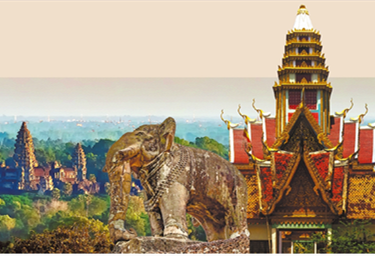Solving the mysteries of what the earth reveals
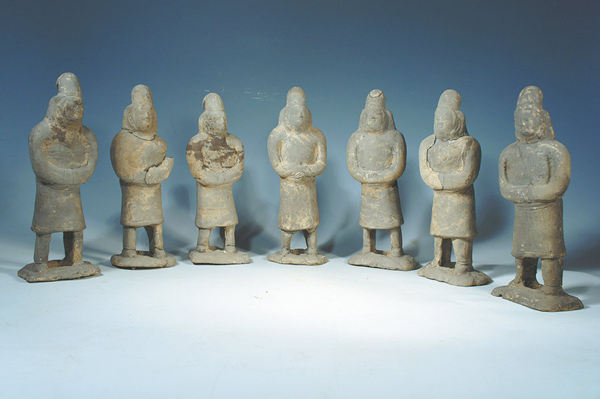
Seven pottery figures from a Northern Wei Dynasty (386-534) tomb. [Photo provided to China Daily]
Deep-eyed and high-nosed pottery figures have recently tugged at Zhu Meng's heartstrings.
They were part of a discovery from a Northern Wei Dynasty (386-534) tomb cluster that was found in Datong, North China's Shanxi province, about a decade ago.
Those pottery figures were generally fashioned to carry an amicable visage and wear round-necked and narrow-sleeved robes and leather belts. Some look like ancient knights with a protruding belly and thick arms while some instrumentalists look as if they are playing either the flute or pipa (a four-stringed plucked lute).
"I'm particularly impressed by the four female figures dressed in long skirts and black hats draped over the back of their heads," says Zhu, a history lover from Taiyuan, capital of Shanxi.
Those pottery items have been restored by experts from the Datong archaeological research institute in Shanxi after years of meticulous work and shed light on more details of a past stretching back more than 1,600 years, according to a statement from the institute.
"They provided new materials for us to study the funerary culture, ethnic costumes, and social life of that time," says Gu Shunfang, an associate researcher with the institute.
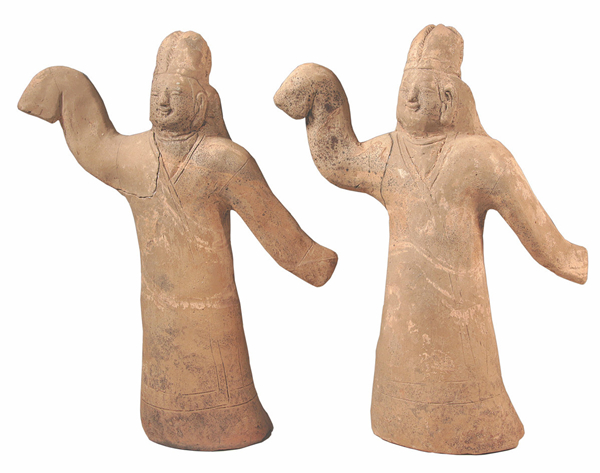
Dancing pottery figures from the M113 tomb. [Photo provided to China Daily]
Marked as M113, the tomb was found in the center of the cluster and produced a total of 51 ancient artifacts.
Apart from one clay item that was not fired, the rest are all earthenware.
In addition to practical wares like those for cooking, most are in the shape of human figures in different circumstances, as well as animals and bullock carts.
For example, some were holding winnowing pans that are indicative of farm work while the entourage and music players all conjure up an image of how the ancients went about their lives.
In ancient tombs, those figures were believed to enable the deceased to continue living in the underworld as they did when they were alive, so they have been considered by archaeologists to have various indicators about past society.
"The ornamentation of those pottery figures, such as the carved clothing style, hair style, and even physical features, reflects the social landscape of the time," Gu says.
Datong was known as Pingcheng in the middle of the Northern Wei Dynasty. Emperor Daowu of Northern Wei settled here in 398 and the capital city was developed until 494, when Emperor Xiaowen of Northern Wei moved it to Luoyang.
In the interim, Datong witnessed the rule of six emperors and became a northern political, economic and cultural center, leaving behind a vast amount of historical treasures.
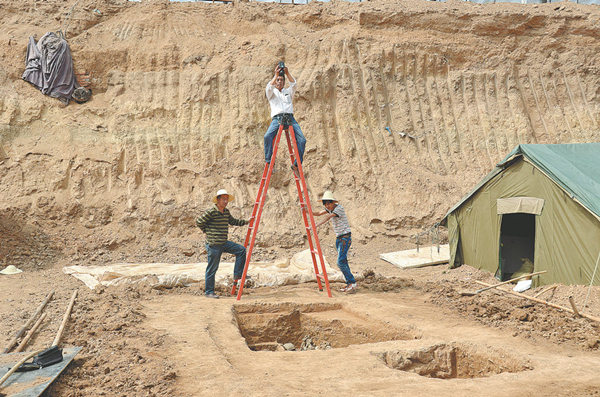
Archaeologists take photos of the relics in the M113 tomb that was found in the center of the cluster and produced a total of 51 ancient artifacts. [Photo provided to China Daily]
Since the country's reform and opening-up, a wave of urban development happened in Datong, where high-rise modern buildings sprang up one after another.
In May 2013, Gu led a team of dozens of archaeological experts to a construction site in the city's Yudong district.
It was a local protocol for archaeological studies to kick in first at construction sites before any concrete piles could be driven into the ground that could potentially yield treasures.
That was when Gu and her team uncovered the tomb cluster with their shovels.
"This tomb cluster was as common as its other Northern Wei Pingcheng tomb counterparts," Gu recalls.
It consisted of 134 Northern Wei tombs, covering a total area of more than 2,000 square meters, equivalent to the size of a residential building base.
"There are many other tomb clusters of similar size in Datong," Gu says.
Despite that, Gu's team worked conscientiously on the site, conducting archaeological surveys to get a clear sense of the stratigraphy, the land's relationship to a time scale, paving the way for excavation and collection.
They had to initially squat for long hours in the archaeological site, excavating with shovels, carefully scraping impurities off the surface of antiques, recording details, mapping the sectional plan, photographing the remains while taking good care of various excavated specimens.
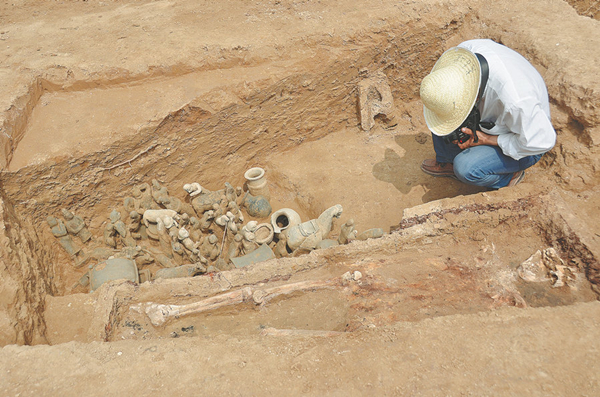
Archaeologists take photos of the relics in the M113 tomb that was found in the center of the cluster and produced a total of 51 ancient artifacts. [Photo provided to China Daily]
Any items that turned up in the cleaning process would be sorted, bagged and recorded before being brought back to the archaeological research institute for subsequent studies and restoration.
As the excavation continued, the appearance of pottery figures from the M113 gave the archaeological team a huge surprise at the beginning of May 2013.
"Never before had it been found that a burial form similar to that of a smaller partial chamber pit tomb would have such a large number of pottery figures with such a rich content," Gu says.
"So it was indeed very exciting when we found those rich figures were undisturbed during the cleanup to the bottom of the tomb."
Through archaeological studies, the tomb complex was found to be dominated by civilian tombs, and only the M113 produced items that are similar to what was found elsewhere in spacious brick-chambered tombs of owners with higher social status, such as that of Sima Jinlong, a member of the nobility of the Northern Wei Dynasty.
"It indicates that the upper and middle classes were not excluded from using small tombs during the Northern Wei Pingcheng period," Gu says.
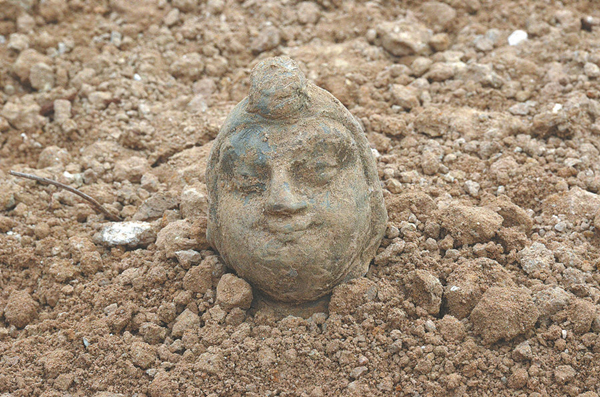
An ancient pottery figure's head found in a tomb cluster in Datong, Shanxi province. [Photo provided to China Daily]
Field excavation of the tomb complex lasted for three months, and then came years of arduous and delicate restoration and research work indoors.
Broken pottery was cleaned, numbered, pieced together, restored, mapped and scanned.
Various specimens were tested, analyzed and counted. Notes kept during the excavation were studied, analyzed and compared with related existing archaeological findings, Gu explains. The work has already lasted for nine years. "It's very rigorous and ponderous," Gu says.
A simple brief in the form of a 5,000-word paper on the M113 excavation illustrates nearly a decade of research efforts by the archaeological team.
A seemingly ordinary photograph or line drawing is the result of a rigorous examination, and a few paragraphs of concluding remarks must give a comprehensive account of the past burial, Gu says.
Each burial was not an independent entity, and must be compared with burials in the surrounding areas of the same period to reach a conclusion, she adds.
Gu compares the work to drawing genealogy.
"It is like introducing a person. You need to involve his or her parents, brothers, relatives, close neighbors and friends before summarizing the data," Gu says.
All the work on the tomb cluster is expected to be finished in two or three years.
"It will be of important value for future academic research," Gu says.
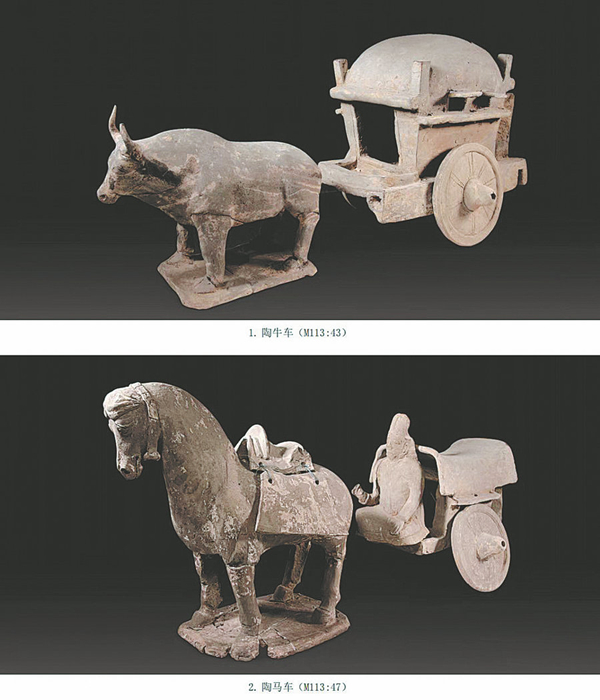
Ox and horse carts found in the cluster. [Photo provided to China Daily]
To local archaeologists, the Northern Wei period is relatively special. There have been many tombs that have been unearthed, yet only a few of them have been definitely dated. Fortunately, characteristics of the artifacts from different periods prove their identity.
The composition of the pottery figures from M113, as well as their round faces and bodies, has led Gu to a conclusion that the tomb owner lived in prosperous times.
"The addition of female worker figures reflected the transition from the early nomadic warring life of Pingcheng in the Northern Wei period to a peaceful and stable domestic life," Gu says.
Having worked in the field of archaeology for 25 years, Gu says she thinks that each unearthed ancient item plays an irreplaceable role in historical research.
"The characteristics of pottery figures will vary slightly with the passage of time," Gu says.
"If the pottery figures excavated at various stages are lined up, the timeline will be clear," she adds.
She says she believes the accumulating research results by generations of archaeologists will gradually fill the gaps in the long Chinese history.
According to the Datong institute, those pottery figures will "meet" the public at Datong Museum in the near future.
The news is exciting for Zhu Meng.
"Most cultural relics give a sense of historical heaviness, but these pottery figurines are exquisite and lovely," Zhu says.
"The vivid life scenes reflected from them draw us, modern people, closer to the ancestors from the Northern Wei Dynasty," she says.
Peng Ke'er contributed to this story.

